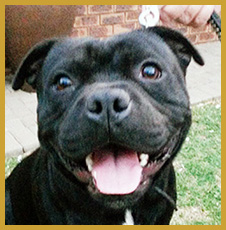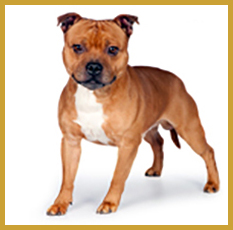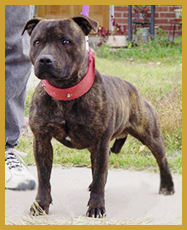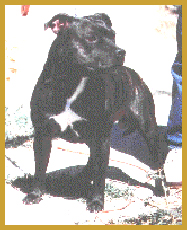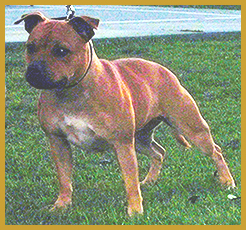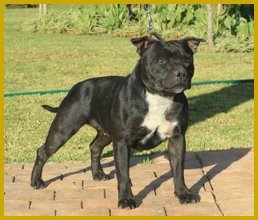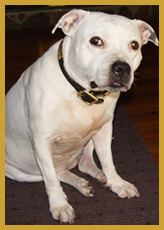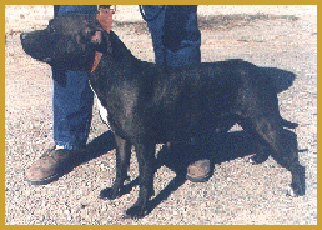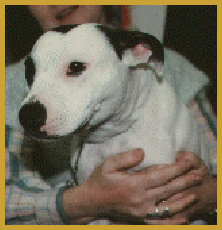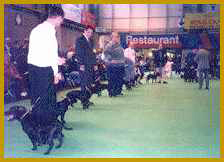SBT Historical Archives
I have copied this from "THE BOOK OF THE DOG", Edited by Brian Vesey-Fitzgerald, published in 1948 by Borden Publishing Co., Los Angeles, California, USA. It speaks for itself.
STAFFORDS AND BAITING SPORTS
By Phil Drabble
I. Dog Fighting
For centuries the men who frequented bull rings and bear pits had enjoyed watching two dogs fight, but it was only with the abolition of bull baiting that dogs were bred and trained specifically for the sport.
It had been found that bulldogs were the only dogs which possessed the requisite courage for the dog-pit but that they lacked the necessary agility. Various bulldog crosses were tried, mainly with terriers, until eventually a specific breed of bull terriers was produced which was fast, strong and utterly game.
From that time dog-fighting increased in popularity. It was spectacular and as searching a test of gameness and capacity to give and take punishment as ever a bull bait was. There was little initial interference from the law, since it was possible to fight two dogs in any hollow or shed without attracting much attention, for fighting dogs fight silently. They were easy to get away afterwards, as they could always be carried in a sack if their condition was likely to draw suspicion. And dog-fighting had the advantage over bull- or bear-baiting in that at least both animals wanted to fight instead of the victim having to be fastened with a rope or chain with no chance of escape.
Early fighting dogs were of all sorts of shapes, sizes and colours since their breeding was very promiscuous. By about 1860 they more or less fell into one of two groups, from one of which the English Bull Terrier was developed and from the other the Staffordshire Bull Terrier. Both breeds were initially very game, since nobody would keep a bull terrier which was not, but men soon bred the English variety for show, and looks were "improved" at the expense of courage. The Staffordshire bull terrier continued to be bred for the pit and, though not very standardised even yet (despite being shown for more than ten years) there is no living breed so game.
There is nothing very complicated in the rules of dog-fighting. The important thing is not so much to kill the other dog as to be game enough to try.
In days when the sport was still legal and at the height of its popularity, between 1820 and 1830, dog-fights were a regular part of the sport at such famous centres of attraction to "the fancy" as the Westminster Pit. The arena here was used indiscriminately for dog-fights, rat-killing contests, cock fights and various freak contests between dog and raccoon or even monkey.
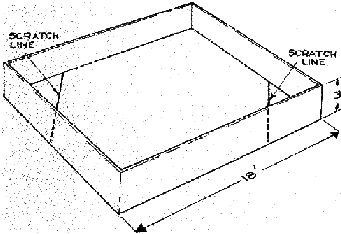
Construction of a pit. The sides can be either plywood or boards, and the substrate can be covered with either a tarpaulin or carpet. (Diagram by Richard Anderson.) Supplied by Paul Skelton from a scan of the diagram from the book " " by s s.
The pit itself was roughly 12-18 feet across, with a boarded surround about three feet high, over which the spectators could watch. Each dog was handled by his second and, after the preliminary formalities concerning the stakes had been completed, each dog was weighed in the pit. It is common for owners of bull terriers which develop a taste for fighting, to boast that their dogs will "kill anything" and that this dog or that "killed an Alsatian" (or something equally big) "in ten minutes." They would alter their tune if they met a real fighting terrier. So much does sheer weight count that matches were rarely made at more than a maximum excess of one pound over the stipulated weight. If a match were made to be fought at "38 lbs give or take a pound", a dog coming to the pit so much as a few ounces over 39 lbs would be disqualified and forfeit the stakes. And two good dogs would sometimes take as much as two hours to decide which was the better and rarely less than 25 or 30 minutes. However good a dog was known to be, nobody but a fool would match him against anything but a cur outside his weight class. And the and who kept fighting terriers considered all breeds to be curs which were not game in the pit.
There was often a good deal of trickery, of the lowest sort, employed to ensure a particular dog winning. He would be rubbed over with acid or pickle or pepper or anything to discourage his opponent from biting him. To avoid this a common butt of water was provided from which both dogs had to be washed, or sometimes milk was used to "kill" the acid. As an additional precaution, each setter was allowed to "taste" (or lick) his opponent's dog both before and after fighting to satisfy himself that nothing pernicious had been used.
When the preliminaries had been completed a coin was tossed to decide which dog should "scratch first*". They were taken to opposite corners of the pit where each second held his dog between his knees so that the other dog got a fair unobstructed view of his opponent's head. On a word from the referee, the dog which had to "scratch" first was liberated and had to go across the pit to attack his opponent. A line was drawn cross the centre of the pit, which was known as the Scratch and the opposing dog could not be loosed until the attacker had crossed this line. When he had crossed the scratch the other setter could loose his dog when ever he liked and it was judgment here that won or lost many battles.
| * Alternatively it was customary in some parts to commence by loosing both dogs simultaneously. The setters could not leave the pit until they commenced fighting, and the first to "fault" had to scratch next time when the battle continued as described above. |
If a setter thought his opponent was not "fast" (or aggressive) he might risk holding his dog quite still and, if the other dog did not begin to fight him, he automatically lost the battle. But if his judgment had been wrong and the other dog did fight at once, the dog which had been held still, until his opponent caught hold of him where he wanted to, was at an obvious disadvantage. If, on the other hand, the setter thought his opponent was pretty fast, his obvious tactics were to loose his dog the moment the other dog crossed the scratch so that they could meet on equal terms. Sometimes a setter opposed to a fast dog would hold his till the last moment and slip him to one side, so that the other dog rushed harmlessly by. He then loosed him, in the hope that he could get a hold before his adversary had recovered his balance. This was an obvious case of "not showing his dog's head fair to scratch" and should have been penalised by the referee.
When both dogs commenced to fight, and not before, the setters could leave the pit and though they could encourage their own dogs they were forbidden to speak to their opponent's dog. Neither dog could be touched again until both stopped fighting, which would eventually happen when they were short of wind or otherwise exhausted. When this happened either setter would pick up his dog. If the opposing dog showed fight he was obliged to put it down again and allow them to continue. If he could get him away unmolested he could take him to his corner and the round had expired. One minute was allowed for sponging down and making ready for the next round, and the referee gave warning after 50 seconds so that both should be ready when the minute was up.
This time the dog who scratched first was held while his opponent came to the scratch and the battle went on again for no set time but until both dogs "faulted" again. Sometimes these rounds lasted for 20 minutes or more. Towards the end of a battle, when both dogs were becoming weak or, short of breath, there might only be a few minutes between scratches. A battle of an hour or more might have twenty scratches, or one dog might be killed in the first scratch. It was very like the old Prize Ring rules where men did not fight for a stipulated time but until one fell to the ground.
The battle was lost by the first dog to fail to come to scratch in his turn. It was not necessarily the dog which killed the other who won but the dog which proved most game. If a dog was killed in the pit the other had to stay at him for ten minutes at least and he could still not be handled by his setter till he faulted. Then he was taken to his corner. If it was the dead dog's turn to scratch the battle was automatically lost. If it was the live dog's turn and he did not scratch, he lost the battle although he had killed his opponent. Dog-fighting has become illegal since the days of the Westminster Pit and by the middle of last century it had to be carried on surreptitiously. It was very popular in London until the beginning of this century and a little has been carried on in the Midlands at intervals since then. Police interference has increased until al] organised dog-fighting in this country has now been stamped out, but game terriers are still bred and exported to America where the sport is still perfectly legal in some States.
It is natural that a sport demanding such gameness should produce some remarkable dogs. I saw a dog only last year which refused to mate a bitch which was dead hot in season. Every time he was loosed he went straight for her throat and we had to choke him off eight times before he eventually mated her and he even tried to worry her when he was knotted. No damage was done as it happened, since she was wearing her broad leather collar. Puppies will fight to kill at three months and bitches are as keen as dogs. Yet some strains are remarkably friendly to other dogs and will put up with unusual insults before being goaded into fighting when once they get a taste for it, they would rather fight than do anything in the world.
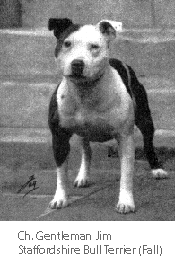
If sheer love of fighting is the prime necessity of the successful fighting dog, correct physique and complete physical fitness are almost equally important. A dog fights with his mouth, and the only places he can sweat are through his tongue and the pores of his feet. And no dog can do much damage with his tongue lolling out.
The first considerations in getting a dog fighting fit are therefore his wind and the removal of all surplus fat. He must be given constant hard exercise to get him muscled up and in dead hard condition, this can be best achieved by giving small quantities of highly nutritious food with an absence of starchy food during training.
The jelly from cows' feet and an adequate supply of fresh green I forms a good basis. Plenty of hard walking on a lead with a wide collar so that can lay himself down and pull helps to strengthen his back and loin muscles. old motor tyre or other piece of rubber hung up so that he can jump up, catch ~ and shake himself about on it is simply vital. The damage a fighting dog is not so much by the sheer force of his bite as by shaking when he has got h And his neck and back muscles are essential for this. Plenty of running jumping for a ball that bounces well strengthens all the muscles he uses in tu~ and twisting, and produces the required agility.
When he is thoroughly fit, the fighting dog is the very personification of energy. His coat glistens until it seems to exude good health. His eye is bright and there is a rippling mass of muscle from his cheeks, and down his neck and shoulder to his loins. He dances like a boxer in the ring and once he has tried fighting he will attack anything that moves, from a mouse to a mule. Although there is no definite type of fighting dog, the breed which was developed for this specific purpose was the Staffordshire Bull Terrier. Many successful dogs were shipped to America, where they became known as "Pit Bull Terriers" and American periodicals devoted to dog-fighting and cockfighting regularly give round-by-round commentaries of the battles their dogs have, at what they call "Pit Bull Terrier Conventions".
Despite the illegality of the sport in this country it has always been carried on spasmodically to a small extent. Periodically the Press write of "orgies" of dog-fighting which are alleged to have been carried on for fabulous stakes, usually behind locked doors in the presence of beautiful women gambling away their fortunes or their honour on the gory result of some battle. In point of fact the reports are usually an elaboration woven round scraps of conversation overheard through the fumes of some bar-parlour.
The battle which may or may not have been described will have taken place in some cellar or pigsty or barn in the presence of from three to five men, all of whom are intimately known to each other. They never fight in the same' place twice. They rarely even keep the dogs they fight, usually collecting them for the occasion from the men who trained them and who will be busily engaged in securing a water-tight alibi elsewhere. And the whole proceedings will be notable more for their sordidness than glamour. Nobody but the people concerned know when or where the next "job" is coming off and the sum total of battles fought is very small, so that chances of detection are negligible.
The dogs themselves take to fighting like a spaniel to the gun and their absolute craziness to get at each other has to be seen to be believed. The men who watch them are of an equally unusual type. That they have little imagination goes without saying. But I find it surprising what a low percentage appear to have taken any purely sadistic delight. They almost worship the quality of aggressive gameness and they are usually as willing to fight each other as to watch their dogs.
I have copied this from "THE BOOK OF THE DOG", Edited by Brian Vesey-Fitzgerald, published in 1948 by Borden Publishing Co., Los Angeles, California, USA.

Phil Drabble
